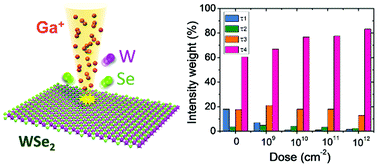Our official English website, www.x-mol.net, welcomes your
feedback! (Note: you will need to create a separate account there.)
Defect creation in WSe2 with a microsecond photoluminescence lifetime by focused ion beam irradiation.
Nanoscale ( IF 5.8 ) Pub Date : 2020-01-08 , DOI: 10.1039/c9nr08390a Qingkai Qian 1 , Lintao Peng , Nestor Perea-Lopez , Kazunori Fujisawa , Kunyan Zhang , Xiaotian Zhang , Tanushree H Choudhury , Joan M Redwing , Mauricio Terrones , Xuedan Ma , Shengxi Huang
Nanoscale ( IF 5.8 ) Pub Date : 2020-01-08 , DOI: 10.1039/c9nr08390a Qingkai Qian 1 , Lintao Peng , Nestor Perea-Lopez , Kazunori Fujisawa , Kunyan Zhang , Xiaotian Zhang , Tanushree H Choudhury , Joan M Redwing , Mauricio Terrones , Xuedan Ma , Shengxi Huang
Affiliation

|
Defect engineering is important for tailoring the electronic and optical properties of two-dimensional materials, and the capability of generating defects of certain types at specific locations is meaningful for potential applications such as optoelectronics and quantum photonics. In this work, atomic defects are created in single-layer WSe2 using focused ion beam (FIB) irradiation, with defect densities spanning many orders of magnitude. The influences of defects are systematically characterized. Raman spectroscopy can only discern defects in WSe2 for a FIB dose higher than 1 × 1013 cm-2, which causes blue shifts of both A'1 and E' modes. Photoluminescence (PL) of WSe2 is more sensitive to defects. At cryogenic temperature, the low-energy PL induced by defects can be revealed, which shows redshifts and broadenings with increased FIB doses. Similar Raman shifts and PL spectrum changes are observed for the WSe2 film grown by chemical vapor deposition (CVD). A four microsecond-long lifetime is observed in the PL dynamics and is three orders of magnitude longer than the often observed delocalized exciton lifetime and becomes more dominant for WSe2 with increasing FIB doses. The ultra-long lifetime of PL in single-layer WSe2 is consistent with first-principles calculation results considering the creation of both chalcogen and metal vacancies by FIB, and can be valuable for photo-catalytic reactions, valleytronics and quantum light emissions owing to the longer carrier separation/manipulation time.
中文翻译:

通过聚焦离子束辐照,在具有微秒光致发光寿命的WSe2中产生缺陷。
缺陷工程对于调整二维材料的电子和光学特性很重要,并且在特定位置产生特定类型缺陷的能力对于诸如光电学和量子光子学之类的潜在应用是有意义的。在这项工作中,使用聚焦离子束(FIB)辐射在单层WSe2中创建原子缺陷,缺陷密度跨越多个数量级。缺陷的影响得到系统地表征。拉曼光谱只能分辨出FIB剂量高于1×1013 cm-2时WSe2中的缺陷,这会导致A'1和E'模式的蓝移。WSe2的光致发光(PL)对缺陷更敏感。在低温下,可以揭示出由缺陷引起的低能PL,随着FIB剂量的增加,其显示出红移和变宽。对于通过化学气相沉积(CVD)生长的WSe2薄膜,观察到了相似的拉曼位移和PL光谱变化。在PL动力学中观察到4微秒长的寿命,比经常观察到的离域激子寿命长3个数量级,并且随着FIB剂量的增加,对WSe2的作用越来越明显。单层WSe2中PL的超长寿命与考虑FIB产生硫族元素和金属空位的第一性原理计算结果一致,并且由于光致发光对光催化反应,谷电子学和量子光发射具有重要价值。更长的载流子分离/操纵时间。在PL动力学中观察到4微秒长的寿命,比经常观察到的离域激子寿命长3个数量级,并且随着FIB剂量的增加,对WSe2的作用越来越明显。考虑到FIB产生硫族元素和金属空位,PL在单层WSe2中的超长寿命与第一性原理计算结果相符,并且由于光致发光对光催化反应,谷电子学和量子光发射具有重要价值。更长的载流子分离/操纵时间。在PL动力学中观察到4微秒长的寿命,比经常观察到的离域激子寿命长3个数量级,并且随着FIB剂量的增加,对WSe2的作用越来越明显。单层WSe2中PL的超长寿命与考虑FIB产生硫族元素和金属空位的第一性原理计算结果一致,并且由于光致发光对光催化反应,谷电子学和量子光发射具有重要价值。更长的载流子分离/操纵时间。
更新日期:2020-01-08
中文翻译:

通过聚焦离子束辐照,在具有微秒光致发光寿命的WSe2中产生缺陷。
缺陷工程对于调整二维材料的电子和光学特性很重要,并且在特定位置产生特定类型缺陷的能力对于诸如光电学和量子光子学之类的潜在应用是有意义的。在这项工作中,使用聚焦离子束(FIB)辐射在单层WSe2中创建原子缺陷,缺陷密度跨越多个数量级。缺陷的影响得到系统地表征。拉曼光谱只能分辨出FIB剂量高于1×1013 cm-2时WSe2中的缺陷,这会导致A'1和E'模式的蓝移。WSe2的光致发光(PL)对缺陷更敏感。在低温下,可以揭示出由缺陷引起的低能PL,随着FIB剂量的增加,其显示出红移和变宽。对于通过化学气相沉积(CVD)生长的WSe2薄膜,观察到了相似的拉曼位移和PL光谱变化。在PL动力学中观察到4微秒长的寿命,比经常观察到的离域激子寿命长3个数量级,并且随着FIB剂量的增加,对WSe2的作用越来越明显。单层WSe2中PL的超长寿命与考虑FIB产生硫族元素和金属空位的第一性原理计算结果一致,并且由于光致发光对光催化反应,谷电子学和量子光发射具有重要价值。更长的载流子分离/操纵时间。在PL动力学中观察到4微秒长的寿命,比经常观察到的离域激子寿命长3个数量级,并且随着FIB剂量的增加,对WSe2的作用越来越明显。考虑到FIB产生硫族元素和金属空位,PL在单层WSe2中的超长寿命与第一性原理计算结果相符,并且由于光致发光对光催化反应,谷电子学和量子光发射具有重要价值。更长的载流子分离/操纵时间。在PL动力学中观察到4微秒长的寿命,比经常观察到的离域激子寿命长3个数量级,并且随着FIB剂量的增加,对WSe2的作用越来越明显。单层WSe2中PL的超长寿命与考虑FIB产生硫族元素和金属空位的第一性原理计算结果一致,并且由于光致发光对光催化反应,谷电子学和量子光发射具有重要价值。更长的载流子分离/操纵时间。











































 京公网安备 11010802027423号
京公网安备 11010802027423号